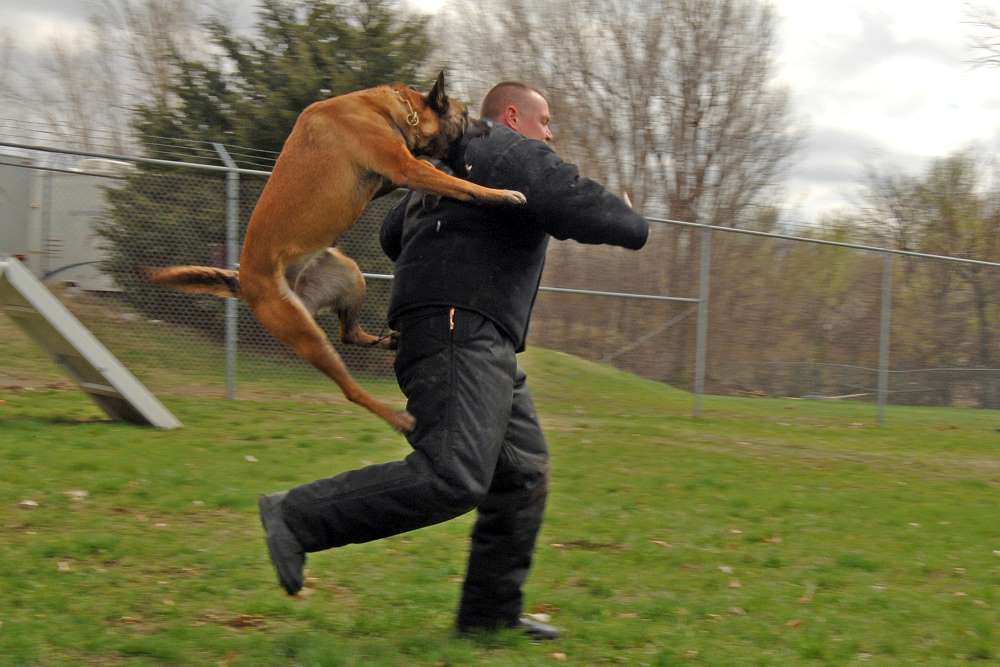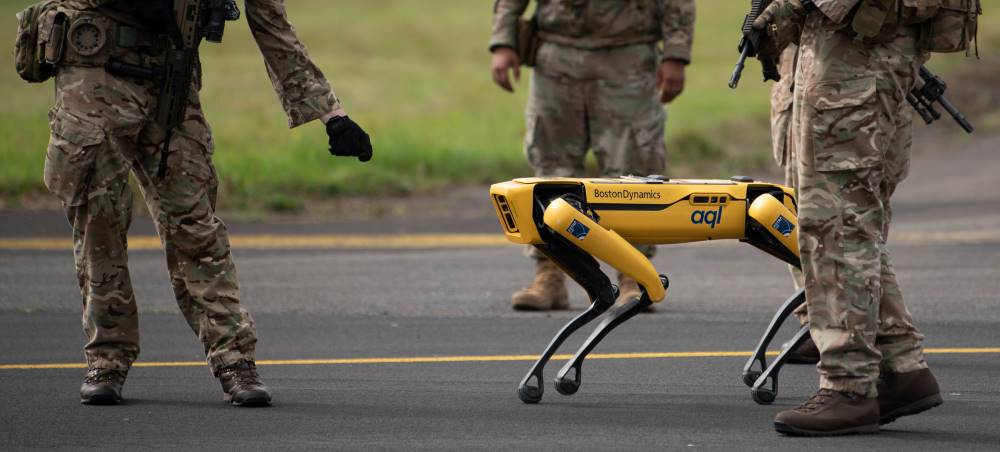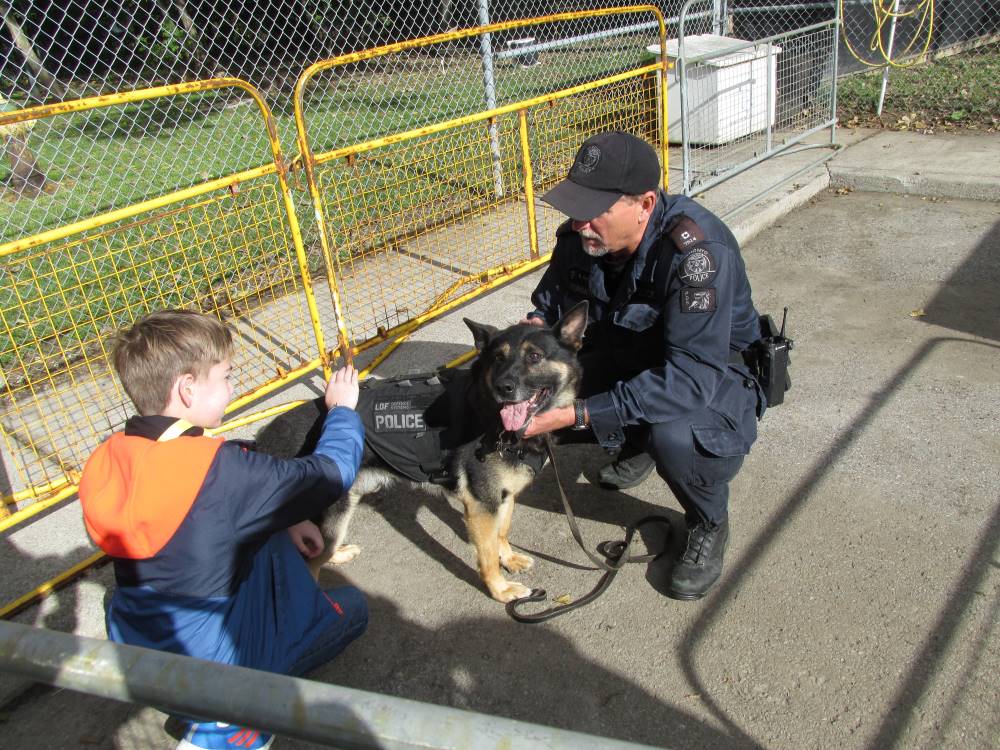As an undergraduate, I worked multiple jobs to make ends meet. For one of those jobs, I was a kennel attendant at a veterinary clinic and earned $7.75 an hour. I was responsible for caring for dogs that were kept in the boarding facility while their (usually affluent) owners were out of town on business or vacation. I kept track of every dog’s diet, administered medications, and took them out for bathroom breaks. It was, without a doubt, the most thankless and exploitative job I’ve ever had. However, I did enjoy the relative solitude and the company of dogs.
One of the frequent boarders and patients of the clinic was Beau, a recently retired police dog. He was a Belgian Malinois, a large working breed that, along with German Shepherds and Bloodhounds, are among the most widely used in K-9 units. Beau was perfectly amicable and never gave me any trouble, although I was half-jokingly warned by his handler “not to use any German words around him.” When I met Beau, the veterinary technicians were quick to share their favorite factoid about him: about half of his teeth had titanium crowns on them. He was “a metalmouth,” as they called him.
As a “bite dog,” Beau’s teeth had sustained massive damage over the years because of his training exercises and performing his “duty” for the department. As his dentition deteriorated, the crowns were put in so he could continue to serve as a nonhuman extension of police power by rending the flesh of those his master targeted. This procedure, which can cost several thousand dollars, is not uncommon for police dogs. This is added to the already substantial annual veterinary costs and upkeep of a K-9 unit. According to K9s4Cops, a nonprofit that raises money to provide grants to police departments to purchase dogs, they can range from $15,000-$45,000 each. The enormous amount of time and capital that goes into weaponizing police dogs often goes unmentioned.

A police dog participating in a routine attack drill with a handler (Wikimedia Commons)
Canines and Racial Capitalism
More robust and targeted calls for defunding, and abolishing police erupted into mainstream political discourse in the wake of George Floyd’s murder by the Minneapolis Police Department last year. These demands are anchored in abolitionist movements stretching back over a century. In light of this, it is worth reexamining the role canines have played as tools of state violence and racial terror more broadly. Some scholars have discussed how dogs have been used in racial capitalist and colonial structures. Sara Johnson has traced the continuities in canine warfare utilized by imperial powers over the centuries, linking the historical role of dogs in the Caribbean and American South in hunting and mutilating Indigenous and enslaved African peoples to their recent usage as torture devices in Abu Ghraib (2009). In relation to the police dog specifically, Tyler Wall convincingly argues that their widespread implementation in the U.S. tactically coincided with the emergence of the Civil Rights Movement, showing that “the promise of the police dog, not unlike the promise of police more generally, was its potential to civilize the savagery of urban (dis)order by pacifying urban space” (2016, 869).
As long as dogs have been domesticated, humans have used them for their labor in various capacities. If dogs are laborers or workers, then they have power insofar as they refuse to work, whether that refusal be made via an assertion of autonomy or succumbing to bodily limitations (Dave 2019). Yet, the police dog is not a worker in the sense that an ox pulling a cart is, or a dairy cow, or even other working dogs like sheepdogs and livestock guardian dogs, all of whom produce surplus value or help secure its extraction in often anthropocentric modes of production. The police dog, however, ensures the reproduction of capitalist social relations by assisting in dealing with another sort of surplus—surplus population. This population includes the masses of under- and unemployed working class, disenfranchised and racialized peoples who inevitably become the targets of police violence and surveillance.
Despite the integral role dogs have played in amplifying the inherent brutality of Western policing and “act[ing] as deliberate agents of empire” (Skabelund 2011, 13), it is imperative to recognize that canines often refuse to be enfolded into such white supremacist projects. The Caribbeanist Bénédicte Boisseron recalls that during the Haitian Revolution, French troops attempted to use bloodhounds to hunt the rebels, hoping the dogs could be trained to target what they understood as a biologizied scent of Blackness. The dogs, however, could not consistently identify such a smell. Boisseron asks, “did the starving dogs simply fail their mission because they could not share the fallacious white fantasy of a distinct black odor? (2018, 58). Similarly, Donna Haraway describes experiments conducted by the apartheid state in South Africa where wolves from North America were imported in order to breed wolfdog hybrids for use in anti-insurgency programs. This effort to conscript canines and transform them into an anti-Black technology also failed; “besides being hard to train, the wolf-dogs…fail[ed] to take the lead when ordered to do so on counterinsurgency or police patrols” (Haraway 2008, 37).
Many prospective police dogs do not pass their intensive training programs and are put up for adoption. Although standards for what constitutes a successful working police or military dog vary widely across different countries, roughly 50-70% fail (Brady et al 2018; Foyer et al. 2016). Even those that pass are not as fanatically obedient as police like to pretend. They can sometimes attack bystanders, or even their own handlers, as evidenced by a 2011 Department of Justice investigation into the New Orleans Police Department. As Beau demonstrates, without expensive veterinary care, their efficacy as weapons can wane quickly as they age. This is particularly so for the larger, favored breeds, which are highly susceptible to hip dysplasia and arthritis.
Given the essential role of dogs to police, their capacity to refuse work or become unable to perform it is a concern for the carceral state. Along with many other nonhumans, police dogs have “unique biological requirements and limitations that challenge and often undermine their treatment as real commodities” (Stuart and Gunderson 2018, 5). They are, as Noel Castree would put it, an example of “incomplete commodification” (2003). I am interested in how modern policing might be adapting to address or overcome the incomplete commodification of the dog, who, at least on a species level, has not acquiesced to becoming a full partner in safeguarding racial capitalism and white supremacy.
When Robocop Goes K-9
Enter Spot is a 65-pound, quadrupedal robot “digidog” developed by the company Boston Dynamics, which has many high-profile clients including British Petroleum. This dexterous canine automaton is advertised primarily for use in the construction, mining, and oil and gas sectors. It can livestream video to check gauges and gather data, laser scan, investigate gas leaks, and detect radiation, among many other tasks. Spot also moonlights in the “public safety” domain, and perhaps its most infamous appearance yet was in a viral cellphone video from last February when the New York Police Department had Spot accompany them on a patrol in the Bronx. Thanks to public outcry from local activists and a hail of negative press about how the digidog could be abused by police, the NYPD canceled its $94,000 contract with Boston Dynamics in April.

Boston Dynamics’ digidog, Spot, during a joint exercise between the U.S. Airforce and the U.K Royal Air Force in August 2021. (Wikimedia Commons)
This dog’s deputization, however, did not begin or end with the NYPD. Both the Massachusetts State Police and Honolulu Police Department are also using it. In the case of the latter, they purchased Spot with $150,000 in federal COVID-19 relief money, and are using it to patrol a homeless encampment and scan people for COVID symptoms. The French Military has also been using Spot in combat exercises. Considering that Spot can also be equipped with a prehensile arm, it doesn’t take much imagination to envision it being modified to become a taser, launch tear-gas canisters, or maybe fire an automatic weapon.
Boston Dynamics has been scrambling to contain the growing controversy regarding how their invention has been put to use and has repeatedly referred to its Ethical Principles—which read like a long-winded, flowery version of Asimov’s Three Laws of Robotics—when fielding inquiries from the press. They insist that their clients are contractually obligated not to weaponize their robots, but if the aforementioned incidents are any indication, they have little control over how police, military, or private security agencies may utilize them. Boston Dynamics also has competitors such as Ghost Robotics who have considerably fewer scruples about how their digidogs can be used, as they recently unveiled a model with a mounted sniper rifle.
The Enduring Asset of the Traditional Police dog
Some have asked if robots will ultimately replace K-9 units. I would argue that we are far from seeing digidogs completely phase out their organic counterparts for at least two reasons. For one, there are, from the perspective of police power, some abilities that dogs possess that robots have yet to replicate. The olfactory capabilities of a dog are incredible, which makes them more adept at seizing drugs, bomb sniffing, etc. It also appears that the digidog—although engineered to ascend stairs, avoid obstacles and traverse uneven terrain—cannot match the speed and mobility of a police dog giving chase in an urban environment. Secondly, and perhaps just as importantly, given the crisis of legitimacy that U.S. policing is experiencing, organic police dogs can be both weapons and public relations assets; they are frequently trotted out when police do community outreach programs at schools or host “Coffee with a Cop” events to give policing a deceptively friendly furry face. Indeed, sometimes this can be their sole purpose. For example, at my institution, the University of Illinois at Urbana-Champaign, the campus police heavily advertised their acquisition of therapy dogs that will accompany officers on patrol, to “provide comfort to victims and others involved in crisis situations” (2021). The mental health benefits of human-animal interactions are well documented, but the addition of the therapy dogs is a transparent attempt to overhaul the department’s image in response to a robust student movement calling for the removal of police from college campuses. While there is a shock and awe factor to the digidog, its aesthetic is unsettling, particularly when coupled with militarized police. Real dogs have them beat in this category until further notice (although the selection of “Spot” as a name is seemingly an attempt to index the romanticized, innocent dog of white, heteronormative nuclear family fantasies). That said, it is likely that we are only seeing the beginnings of digidogs and other robocops in the “domestic warfare” (Rodriguez 2020) being waged by police.

A child pets a police service dog at an open house for the Toronto Police Department (Wikimedia Commons)
The opposition to digidogs in places like New York City is, rightfully so, rooted in a fear of the terrifying technofascist possibilities of widespread incorporation of robots into police and military forces. However, examining the longer history of the K-9 unit reveals that the usage of nonhuman animals, or any living being, in racial capitalist policing regimes is no more natural than creating robots for this purpose. Living police dogs are weapons engineered via an enormity of resources: funding, training, veterinary interventions, and violent coercion. Like digidogs, they are inventions and are just as dystopian, if not more so. Why, then, should resistance to dogs in police forces recede at the boundary of non-living and living?
Rather than pursue a reformist route of restricting only robot dogs, how might the rise of the digidog impel us to interrogate how police power is routed through the nonhuman more broadly? The compulsory enlistment of animals like dogs and horses by police and the abuse they endure in this capacity has often been a concern of animal rights groups. As Alex Moyle (2018) suggests, it is an issue that potentially unites animal and environmental activists with forms of anti-racist—and I would add abolitionist—organizing. How could such a coalition denaturalize the normative assumptions about K-9 units by creating other narratives? How could they disrupt the processes of nonhuman weaponization, whether those weapons be robotic or animal? The “beastiality of police power” (Wall 2016, 877) is indeed vast and horrifying, but as I hope I have shown here, it is neither natural nor inevitable. It is, rather, quite fragile at times. The policeman’s yoke over the beast might be broken by exploiting such cracks in the armor of the carceral state.
References
Boisseron, Bénédicte. 2018. Afro-Dog: Blackness and the Animal Question. New York: Columbia University Press.
Brady, Karen, Nina Cracknell, Helen Zulch, and Daniel S. Mills. 2018. “Factors associated with long-term success in working police dogs” Applied Animal Behaviour Science 207: 67-72. https://doi.org/10.1016/j.applanim.2018.07.003
Castree, Noel. 2003. “Commodifying What Nature?” Progress in Human Geography 27( 3): 273–297. doi:10.1191/0309132503ph428oa.
Dave, Naisargi N. 2019. “Kamadhenu’s Last Stand: On Animal Refusal to Work.” In How Nature Works: Rethinking Labor on a Troubled Planet. Edited by Sarah Besky and Alex Blanchette. Santa Fe, NM: School for Advanced Research Press.
Foyer, Pernilla, Anna-Maria Svedberg, Emma Nilsson, Erik Wilsson, Åshild Faresjöd, and Per Jensen. 2016. “Behavior and cortisol responses of dogs evaluated in a standardized temperament test for military working dogs” Journal of Veterinary Behavior 11: 7-12. https://doi.org/10.1016/j.jveb.2015.09.006
Haraway, Donna J. 2008. When Species Meet. Minneapolis, MN: University of Minnesota Press.
Johnson, Sara E. 2009. “‘You Should Give them Blacks to Eat’” American Quarterly 61(1): 65-92. DOI: 10.1353/aq.0.0068
Moyle, Alex. 2018. “Using Dogs as a Tool of Racist Repression.” Socialist Worker, July 17, 2018. https://socialistworker.org/2018/07/17/using-dogs-as-a-tool-of-racist-repression
Rodriguez, Dylan. 2020. White Reconstruction: Domestic Warfare and the Logics of Genocide. New York, NY: Fordham University Press.
Skabelund, Aaron Herald. 2011. Empire of Dogs: Canines, Japan, and the Making of the Modern Imperial World. Ithaca, NY: Cornell University Press.
Stuart, Diane and Ryan Gunderson. 2018. “Nonhuman Animals as Fictitious Commodities: Exploitation and Consequences in Industrial Agriculture.” Society & Animals 26(1): 1-20.
United States Department of Justice Civil Rights Division. 2011. “Investigation of the New Orleans Police Department” March 16, 2011. https://www.justice.gov/sites/default/files/crt/legacy/2011/03/17/nopd_report.pdf
University of Illinois Police. 2021. “Comfort in a crisis: Two therapy dogs join UIPD support team.” UIPD Blog, Jan. 26, 20121. https://blogs.illinois.edu/view/6221/1213809274
Wall, Tyler. “‘For the Very Existence of Civilization’: The Police Dog and Racial Terror.” American Quarterly 68(4): 861-882. DOI: https://doi.org/10.1353/aq.2016.0070
